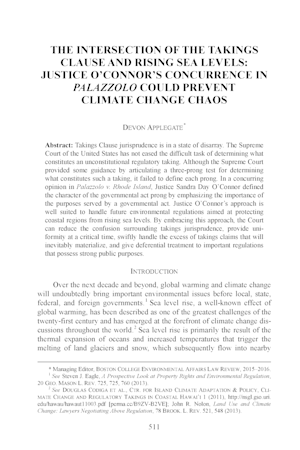The Intersection of the Takings Clause and Rising Sea Levels: Justice O'Connor's Concurrence in Palazzo Could Prevent Climate Change Chaos
January 2016

Other pages in the O'Connor Institute Online Archive mentioned in this article:
| NAME / TITLE | TYPE |
|---|---|
| Palazzolo v. Rhode Island | Supreme Court Opinion |
DISCLAIMER: This text has been transcribed automatically and may contain substantial inaccuracies due to the limitations of automatic transcription technology. This transcript is intended only to make the content of this document more easily discoverable and searchable. If you would like to quote the exact text of this document in any piece of work or research, please view the original using the link above and gather your quote directly from the source. The Sandra Day O'Connor Institute does not warrant, represent, or guarantee in any way that the text below is accurate.
Article Text
(Excerpt, Automatically generated)
THE INTERSECTION OF THE TAKINGS CLAUSE AND RISING SEA LEVELS: JUSTICE O'CONNOR'S CONCURRENCE IN PALAZZOLO COULD PREVENT CLIMATE CHANGE CHAOS
DEVON APPLEGATE*
Abstract: Takings Clause jurisprudence is in a state of disarray. The Supreme Court of the United States has not eased the difficult task of determining what constitutes an unconstitutional regulatory taking. Although the Supreme Court provided some guidance by articulating a three-prong test for determining what constitutes such a taking, it failed to define each prong. In a concurring opinion in Palazzolo v. Rhode Island, Justice Sandra Day O'Connor defined the character of the governmental act prong by emphasizing the importance of the purposes served by a governmental act. Justice O'Connor's approach is well suited to handle future environmental regulations aimed at protecting coastal regions from rising sea levels. By embracing this approach, the Court can reduce the confusion surrounding takings jurisprudence, provide uni formity at a critical time, swiftly handle the excess of takings claims that will inevitably materialize, and give deferential treatment to important regulations that possess strong public purposes.
INTRODUCTION
Over the next decade and beyond, global warming and climate change will undoubtedly bring important environmental issues before local, state, federal, and foreign governments. 1 Sea level rise, a well-known effect of global warming, has been described as one of the greatest challenges
